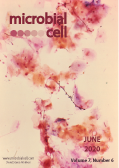Table of contents
Volume 7, Issue 6, pp. 143 - 161, June 2020
Cover: Photomicrograph of a Gram-stained vaginal smear specimen under a low power magnification, revealing the presence of the fungal organism, Candida albicans in a case of monilial vaginitis, more commonly referred to as vaginal candidiasis. Image by Stuart Brown (Centers for Disease Control and Prevention, USA; Public Health Image Library, image ID #18989); image modified by MIC. The cover is published under the Creative Commons Attribution (CC BY) license.
Enlarge issue cover
Fungal infections in humans: the silent crisis
Katharina Kainz, Maria A. Bauer, Frank Madeo and Didac Carmona-Gutierrez
Editorial |
page 143-145 | 10.15698/mic2020.06.718 | Full text | PDF |
Abstract
Annually, over 150 million severe cases of fungal infections occur worldwide, resulting in approximately 1.7 million deaths per year. Alarmingly, these numbers are continuously on the rise with a number of social and medical developments during the past decades that have abetted the spread of fungal infections. Additionally, the long-term therapeutic application and prophylactic use of antifungal drugs in high-risk patients have promoted the emergence of (multi)drug-resistant fungi, including the extremely virulent strain Candida auris. Hence, fungal infections are already a global threat that is becoming increasingly severe. In this article, we underline the importance of more and effective research to counteract fungal infections and their consequences.
Broad-spectrum antifungal activities and mechanism of drimane sesquiterpenoids
Edruce Edouarzin, Connor Horn, Anuja Paudyal, Cunli Zhang, Jianyu Lu, Zongbo Tong, Guri Giaever, Corey Nislow, Raja Veerapandian, Duy H. Hua and Govindsamy Vediyappan
Research Articles |
page 146-159 | 10.15698/mic2020.06.719 | Full text | PDF |
Abstract
Eight drimane sesquiterpenoids including (-)-drimenol and (+)-albicanol were synthesized from (+)-sclareolide and evaluated for their antifungal activities. Three compounds, (-)-drimenol, (+)-albicanol, and (1R,2R,4aS,8aS)-2-hydroxy-2,5,5,8a-tetramethyl-decahydronaphthalene-1-carbaldehyde (4) showed strong activity against C. albicans. (-)-Drimenol, the strongest inhibitor of the three, (at concentrations of 8 – 64 µg/ml, causing 100% death of various fungi), acts not only against C. albicans in a fungicidal manner, but also inhibits other fungi such as Aspergillus, Cryptococcus, Pneumocystis, Blastomyces, Saksenaea and fluconazole resistant strains of C. albicans, C. glabrata, C. krusei, C. parapsilosis and C. auris. These observations suggest that drimenol is a broad-spectrum antifungal agent. At a high concentration (100 μg/ml) drimenol caused rupture of the fungal cell wall/membrane. In a nematode model of C. albicans infection, drimenol rescued the worms from C. albicans-mediated death, indicating drimenol is tolerable and bioactive in metazoans. Genome-wide fitness profiling assays of both S. cerevisiae (nonessential homozygous and essential heterozygous) and C. albicans (Tn-insertion mutants) collections revealed putative genes and pathways affected by drimenol. Using a C. albicans mutant spot assay, the Crk1 kinase associated gene products, Ret2, Cdc37, and orf19.759, orf19.1672, and orf19.4382 were revealed to be involved in drimenol’s mechanism of action. The three orfs identified in this study are novel and appear to be linked with Crk1 function. Further, computational modeling results suggest possible modifications of the structure of drimenol, including the A ring, for improving the antifungal activity.
A novel c-di-GMP signal system regulates biofilm formation in Pseudomonas aeruginosa
Gukui Chen and Haihua Liang
Microreviews |
page 160-161 | 10.15698/mic2020.06.720 | Full text | PDF |
Abstract
The bacterial second messenger cyclic-di-GMP (c-di-GMP) controls biofilm formation and other phenotypes relevant to pathogenesis. The human pathogen Pseudomonas aeruginosa encodes 17 diguanylate cyclase (DGCs) proteins which are required for c-di-GMP synthesis. Therefore, the c-di-GMP regulatory system in P. aeruginosa is highly sophisticated. SiaD, one of the DGC enzymes, is co-transcribed with SiaA/B/C and has been shown to be essential for bacterial aggregate formation in response to environmental stress. However, the detailed function of this operon remains unknown. In our recent paper (Chen et al., doi: 10.15252/embj.2019103412), we have demonstrated that the siaABCD operon encodes a signaling network that regulates biofilm and aggregate formation by modulating the enzymatic activity of SiaD. Among this signaling system, SiaC interaction with SiaD promotes the diguanylate cyclase activity of SiaD and subsequently facilities the intracellular c-di-GMP synthesis; SiaB is a unique protein kinase that phosphorylates SiaC, whereas SiaA phosphatase can dephosphorylate SiaC. The phosphorylation state of SiaC is critical for its interaction with SiaD, which will switch on or off the DGC activity of SiaD. This report unveils a novel signaling system that controls biofilm formation, which may provide a potential target for developing antimicrobial drugs.










